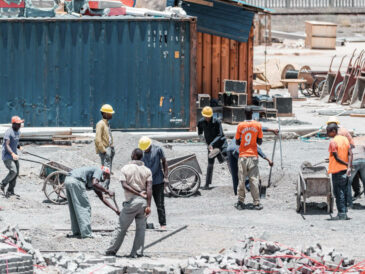There have been recorded instances of social unrest in South Africa at a rate that is among the highest of any country on the planet. The reasons for this are significantly more nuanced than is commonly believed.
As a result of the magnitude and severity of the ransacking and sabotage that took place in KwaZulu-Natal and parts of Gauteng in July, which followed the imprisonment of former President Jacob Zuma, social protest and civil unrest have entered the popular discourse.
However, a significant portion of the commentary on the riot in July – which resulted in the loss of over 300 lives and caused billions of rands worth of damage to the economy – ignored the extended history of violent rebellion in the nation. The reality is that even though dissatisfaction among Zuma’s followers was the spark that set off the unrest, the causes of social instability go much deeper.
In addition to this, the data that is currently available demonstrates that the number of demonstrations that have taken place in South Africa over the past 20 years has been steadily increasing. When comparing the years 2004-2008 to 2015-19, we see, for example, that the annual average number of protests regarding the delivery of services has increased by almost nine times. In addition, there is proof that public demonstrations are becoming more destructive and violent over time.
It is essential to gain an understanding of the factors that are contributing to the current trend of escalating social unrest, which places the nation in a precarious position, as well as the potential solutions to the underlying problems.
If the government wishes to prevent a reoccurrence of the social and economic disaster that was caused by the riots in July 2021 – even if it is on a smaller and more localized scale – it should look back to discover some valuable lessons about why demonstrations happen and how to resolve this.
Seedlings of Dissatisfaction
Understanding the causes of social unrest in South Africa requires taking into account several important factors, including the following:
To begin, it is essential to acknowledge that the people and locations that suffer the greatest levels of economic and social poverty are not necessarily the ones who are most likely to participate in protests. Protests, for instance, over “service delivery,” which refers to the provision of fundamental services including electricity, water, and sanitation, are especially pronounced in the urban centers, such as Johannesburg, Cape Town, eThekwini, Tshwane, Nelson Mandela Bay, and Mangaung. These protests have been going on for quite some time. Despite this, the levels of service coverage in rural municipalities are significantly lower.
Over the past two decades, there has been a general improvement in people’s provision of basic amenities across the country. However, there has been a meteoric rise in the number of delivery protests over the same period. When and why the inefficient distribution of municipal services results in social conflict is almost certainly tied to a web of deeper and more convoluted causes and conditions.
Second, tiers of provision are not the only factor that can lead to gripes and discontent, which can then spark social protest. A perception of inequity (inequality) is often what leads to these feelings. For instance, distinctions in amenities that have been around for a long time between communities that are adjacent to one another send a clear message that the government is either unwilling or unable to satisfy their requirements equitably.
One good example of this is the prevalence of political unrest in squatter camps and other types of informal settlements. Despite arriving in the city with high hopes for a better life, many migrants from rural areas end up living in deplorable conditions once they settle there. This will likely continue as long as the government is unable to put into action a strategy for updating informal settlements that is both feasible and scalable.
Third, government agencies have the propensity to become obsessed with reaching numerical targets, often at the cost of the quality of the services they provide and the things that are most important to the communities they serve. Recent findings indicate that municipal authorities get stuck in a culture of “playing it safe” and “conformance” when it comes to providing services and associated public investments rather than innovating and genuinely transforming their organizations.
One notorious example is the placement of toilets in an open field by municipalities, after which contractors are compensated to erect the toilets, regardless of whether or not any homes or citizens are residing in the immediate area.
The government must stop giving the ideas of public consultations and local participation “lip service” and start taking this work seriously instead. By connecting municipal strategies and investments closer to the actual priorities of the people, the additional time and effort that is required are justifiable. Having support from the community can also help guarantee that funds for public infrastructure will be preserved and well-maintained.
After decades of waiting for promises to be kept, one’s feelings of anger and disappointment have likely become amplified. According to the findings of numerous international studies, communities are more likely to stage demonstrations when they can unambiguously assign blame and when visible organizations are interpreted to possess the means to provide redress.
Municipal services provide a direct line of sight for communities, making it simple for them to measure and attest to the progress that has been made in their experience of day-to-day life. In recent years, the failure of many municipalities is attributable to poor management as well as widespread corruption. This is especially true in smaller towns and cities where the concept of raw sewage flowing through the streets and empty pipes brings to mind disturbing images. Complaints regarding the quality of the service provided are one example of a common motivator for social unrest. On the other hand, the grievances frequently reflect a much wider swath of general discontent.
During the pandemic, a disproportionate number of poorer urban communities have lost jobs and other sources of income, which has made the difficulties and suffering that these communities have been experiencing over the past 18 months even worse. Food shortages and insecurity are not only moral issues but also an issue that is essential for maintaining social stability.
The recently announced continuation of the R350 special COVID-19 monthly grant should assist in alleviating some of the urgent pressures that are being placed on households with lower incomes. However, the nation also requires a more detailed strategy for how it intends to address the issue of food shortages.
This is No Short-Term Fix
The deep-rooted social divisions and separated living conditions in South Africa offer fertile soil for social unrest. This is the heart of the matter. There is no simple solution to these problems.
The number of people living in metropolitan areas keeps growing. This places additional strain on poorer communities that are already struggling to deal with increasing density, the strain on services, casualness, and limited economic opportunities. The job of improving and changing these neighborhoods is made even more difficult by the presence of fragmented communities as well as weak and under-resourced governing institutions.
In the meantime, households with more financial resources can buy their way into locations that are secure, carefully planned, and have facilities of a higher quality. They have the option of avoiding using government services by purchasing private medical care, education, and protection instead. This highlights the socioeconomic split even more starkly than before.
There is a very real possibility that the current economic crisis will accelerate the deterioration of public services. As a result, there will be an increase in the number of families belonging to the middle class that opts to purchase private provisions. If the government does not address this problem, the gap that is growing between middle-class and working-class communities will exacerbate existing feelings of unfairness and make it more difficult to maintain social stability.





